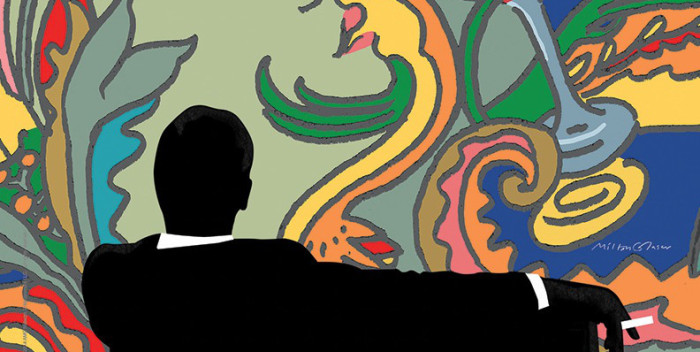Exclusive: “Mad Men” Tying Together Finale-Coke Commercial-Beatles (Watch, Listen)
by Martin Lewis
May 20, 2015

The choice of song for the grand finale of “Mad Men” – the iconic 1971 Coca Cola advert “I’d Like To Buy The World A Coke” – which subsequently became the worldwide hit single “I’d Like To Teach The World To Sing” – prompted our good friend producer/writer/pop culture historian Martin Lewis to scribble a few recollections of the genesis of that song that pre-date the idea of real-life 1960s Mad Man Bill Backer of McCann Erickson.
It was McCann Erickson creative director Bill Backer who in early 1971 came up with the slogan “I’d like to buy the world a Coke and keep it company” as an idea for a Coca Cola ad campaign. But he knew it needed to become a jingle to make it succeed. So he turned to a successful British pop-writing duo Roger Cook & Roger Greenaway and gave them the challenge.
The duo wrote massive worldwide hits such as the Hollies’ 1972 smash “Long Cool Woman in a Black Dress,” “You’ve Got Your Troubles” (#7 Billboard for The Fortunes in August 1965), “My Baby Loves Lovin” (White Plains, 1970) and many more.
Cook and Greenaway didn’t take long to write a song extolling the virtues of Coca Cola. They simply repurposed a song they’d already written titled “True Love and Apple Pie” – which they had written and produced for a perky Liverpudlian songbird named Susan Shirley. See her perform the song on a 1971 UK TV show here:
The song wasn’t a hit until they first changed the lyrics into a jingle for Coke – and then into yet another version without referencing the product – which was released by both the New Seekers and the Hillside Singers under its new title “I’d Like To Teach The World To Sing”.
The “peace ‘n’ love” all-races-living-together-in-harmony philosophy heard in the new lyrics and seen in the iconic hillside TV commercial for Coca Cola was also recycled from an earlier Cook & Greenaway song – a massive UK hit single in 1969 called “Melting Pot” by the group Blue Mink which featured lead vocals by Cook and American soul singer Madeline Bell. (The band also included legendary bassist Herbie Flowers who played the iconic bass-line on Lou Reed’s “Walk On The Wild Side”)
The lyrics were a plea for racial harmony and name-checked (among others) the Beatles, Mick Jagger, Marianne Faithfull and the Queen!
The chorus:
What we need is a great big melting pot
Big enough to take the world and all it’s got
Keep it stirring for a hundred years or more
Turn out coffee-colored people by the score!
Here is Blue Mink singing the song on a 1969 TV show.
And reprising the song in a 1995 TV reunion of the core trio of Blue Mink (Cook, Bell & Flowers)
Incidentally Cook & Greenaway were not new to the US charts. In 1966 they had a Billboard Top Twenty hit as performers. At that time they were a British Invasion singing duo in the vein of Peter & Gordon known as “David & Jonathan”. Their version of the Beatles’ “Michelle” reached #18 in Billboard. Their recording – the first cover of a song from the Beatles’ “Rubber Soul” album – had the inside track as it was arranged and produced by Beatles producer George Martin. Who also arranged and produced their 1967 cover of “She’s Leaving Home”. It was George Martin who first spotted their talent and signed them to his AIR production company. He produced all their recordings.
Their version of “She’s Leaving Home” is very important in the Beatles universe because it indicates how George Martin might have arranged the song for the “Sgt Pepper” album had Paul McCartney permitted him! McCartney had been in a hurry to record his new song and because George Martin was unavailable the day before the scheduled session (he was busy producing the Beatles’ pal Cilla Black that day) McCartney imperiously commissioned another arranger – future Gary Glitter producer Mike Leander) to score the song. George Martin regarded Leander’s score as saccharin but gamely conducted the string section and produced the Beatles recording anyway. So arranging and producing David & Jonathan’s version of the same song a few weeks later gave him the opportunity to present the tune as he thought the orchestration should have sounded!


No hay comentarios:
Publicar un comentario